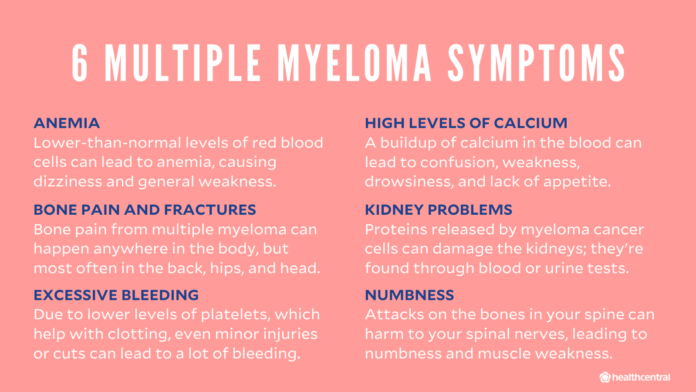Symptoms of Multiple Myeloma
When symptoms do occur, they may include the following:
- Bone pain, most often in the spine, pelvis, or ribs
- Thrombocytopenia, or low levels of platelets in the blood, which can cause increased bruising and bleeding
- Bone fractures
- Fatigue
- Weakness
- Frequent infections
- Weakness or numbness in the legs
- Excessive thirst
- Constipation
- Nausea
- Loss of appetite
Learn About The Symptoms of Multiple Myeloma
Causes and Risk Factors of Multiple Myeloma
Known risk factors for multiple myeloma include the following considerations:
- Age Multiple myeloma is most often diagnosed in adults over age 65.
- Gender Men are at a slightly higher risk than women.
- Race Black Americans are almost twice as likely to get multiple myeloma as white Americans.
- Family History Having a close relative with multiple myeloma increases a person's odds of developing it. Is multiple myeloma hereditary? Sometimes. But most people with multiple myeloma have no family history of the disease.
- Obesity People who are overweight or obese are at a higher risk.
- Other Plasma Cell Diseases Multiple myeloma may start out as a relatively benign condition called monoclonal gammopathy of undetermined significance (MGUS), according to the American Cancer Society.
Treatment and Medication Options for Multiple Myeloma
Multiple myeloma has long been considered an incurable disease. It’s extremely rare for a patient to be considered cured. But many patients keep their cancer at bay for long periods of time with treatment. It’s typical for patients to experience periods of symptomatic myeloma, which requires treatment, followed by periods of remission, in which a person may not need to be treated.
Current treatments aim to relieve symptoms, prolong periods of remission, and prolong survival. Oncologists have many ways to treat multiple myeloma and will typically use more than one at a time. Treatments include the following options:
- Chemotherapy and Targeted Drugs This includes targeted drugs that home in on specific genes or proteins on cancer cells.
- Stem Cell Transplantation Cancerous cells are replaced with healthy stem cells from the patient’s own system or a matched donor. Stem cell transplants are often followed by maintenance therapy with a drug such as Revlimid (lenalidomide).
- Radiation Therapy This therapy uses high-energy rays to kill cancer cells. It’s often used to target areas of bone damaged by multiple myeloma.
- Surgery Multiple myeloma can cause bone deterioration that results in weakened or fractured bones. Surgery may be used to fortify areas of bones to make them more stable.
- Clinical Trials New drugs and drug combinations are constantly being investigated for treating multiple myeloma and other cancers.
Learn More About Treatment for Multiple Myeloma
Multiple Myeloma Research and Statistics
According to the most recent statistics from the National Cancer Institute, almost 31,000 Americans received a multiple myeloma diagnosis in 2018.
That makes multiple myeloma relatively rare, accounting for 1.8 percent of all new cancer cases.
Around 0.8 percent of men and women in the United States will be diagnosed with multiple myeloma at some point during their lives.
Additional Resources for Multiple Myeloma
If you’ve been diagnosed with multiple myeloma, a number of excellent resources can help you understand and cope with your condition. Click on the link below for more information on organizations, blogs, and websites that provide a wealth of information as well as medical, emotional, and financial support for people with multiple myeloma.
Learn More About Resources for Multiple Myeloma
With additional reporting by Kaitlin Sullivan.
Editorial Sources and Fact-Checking
What Is Multiple Myeloma? American Cancer Society. February 28, 2018.
Multiple Myeloma. Mayo Clinic. December 15, 2017.
Possible Medical Problems Related to Myeloma. International Myeloma Foundation.
Can Multiple Myeloma Be Found Early? American Cancer Society. February 28, 2018.
Risk Factors for Multiple Myeloma. American Cancer Society. February 28, 2018.
Can Multiple Myeloma Be Prevented? American Cancer Society. July 4, 2020.
Myeloma: Diagnosis. Leukemia & Lymphoma Society.
Myeloma Signs and Symptoms. Leukemia & Lymphoma Society.
Multiple Myeloma Stages. American Cancer Society. February 28, 2018.
Multiple Myeloma: Survivorship. Cancer.Net. July 2018.
SEER Cancer Stat Facts: Myeloma. National Cancer Institute.
About Multiple Myeloma. USCF Helen Miller Family Comprehensive Cancer Center. 2018.
Myeloma: Treatment. Leukemia & Lymphoma Society.
African American Initiative. International Myeloma Foundation.
Possible Medical Problems Related to Myeloma. International Myeloma Foundation













































